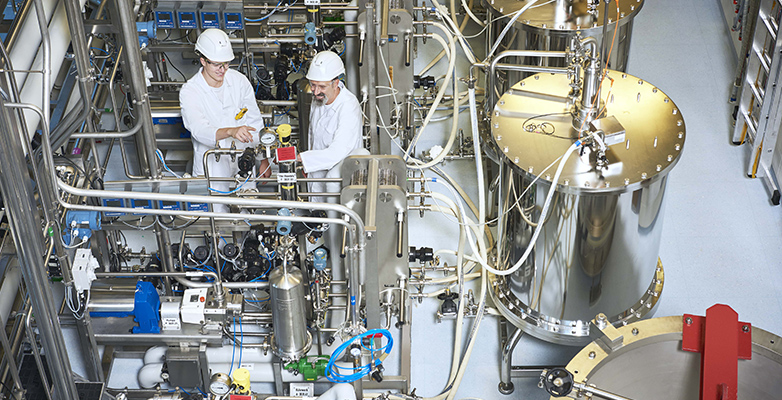With headquarters in Basel, Switzerland, Novartis has a global reach of approximately 129,000 associates worldwide and sells products in 155 countries. The company offers a diversified portfolio consisting of medicines, generic and biosimilar pharmaceuticals, and eye care.
The Novartis supply network for the Innovative Medicines division is composed of 16 sites. Not long ago, on-time-in-full delivery reliability was 40 percent, with about 400 stock keeping units (SKUs) out of stock from a total portfolio of 10,000 SKUs. This, in turn, led to a 97 percent customer service level, which impaired patient access to medicines and damaged business performance. Trust eroded between commercial and supply operations — each blaming the other for poor forecasting or undependable supply. Functional silos were common and firefighting was the norm.
“People had lost connection to how the supply chain was designed to operate,” says Ian Anderson, Novartis Operational Standards for Supply Chain Excellence global program head. “Planning competencies had degraded, leading to the supply chain becoming more reactive.”
Novartis leaders responded by committing to a transformation project that would improve operating efficiency and enable higher levels of service. The primary program goals were to ensure patients always have access to medicines and maximize business success. Decision-makers based the transformation on APICS Certified in Production and Inventory Management (CPIM) education. In the end, this initiative was so successful that it was honored with the 2018 APICS Award of Excellence — Transformation.
In addition to CPIM courses taught to reinforce learning and education on-site, core CPIM principles were adapted to the specific needs of the Novartis business and documented in a set of internal standards: Novartis Operational Standards for Supply Chain Excellence (NOSSCE). The processes were defined in a manual and measured via 23 key-performance indicators (KPIs). In addition, Novartis created a checklist to help each site measure progress against the defined standards.
“APICS CPIM is a foundation to gain a common understanding and a common language about how a supply chain is designed to operate,” Anderson explains. “This is so important; it is vital that people understand the supply chain theory and then use this knowledge to implement sustainable processes in each local business unit.”
Initially, external consultants were employed to work with each site. Later, an internal NOSSCE global team took over. The role of the team members was to educate and coach site employees on NOSSCE. A local organization at each of the 16 sites drove the transformation. This constituted a fulltime NOSSCE leader reporting to the site head and eight-to-10 part-time work stream leaders. Each work stream was sponsored by a leadership team member and populated by part-time subject-matter experts. The objective was to directly involve nearly 10 percent of the site population.
Best-in-class companies were benchmarked directly, through consultants or the experiences of Novartis employees who had worked in these organizations. In addition, a blueprint was created for all critical roles and documented in the NOSSCE manual. Implementation was mandatory.
“The powerhouse in the transformation was the people at each site who embarked on their NOSSCE program,” Anderson says, adding that site leadership teams experienced a day-long education program to identify how the NOSSCE transformation would integrate with site strategy. Then, each site leadership team determined its particular target benefits, which were typically related to supply reliability, lead times, inventory and operating efficiency.
Sites reported to a senior management governance committee each month on implementation progress, KPIs and process status. Along the way, one important discovery was that advancement was totally dependent on leadership commitment. Anderson says the initial top-down, senior management mandate was essential, but individual site leadership team commitment was paramount: “We learned that we needed to establish a deep belief, understanding and sense of purpose in the majority of site leadership team members,” he explains. “Without this, real and sustainable progress was impossible.”
A second key discovery was how difficult it was to define clear processes and appropriate KPIs in a large and diverse company with a variety of different business models. Anderson believes Novartis succeeded as a direct result of the NOSSCE process manual, metrics handbook, KPIs and checklist, which establish facts about process performance and take away a lot of the natural emotion and resistance that can come during any transformation.”
Lastly, Novartis supply chain professionals gained considerable knowledge by tackling some of the cultural challenges they faced during the implementation of the process indicators. “We had to work hard to focus people on root-cause analysis and systematic continuous improvement, rather than seeking a quick fix,” Anderson says. “The improved teamwork has definitely given staff a better quality of life. They have pride in what they do and are happy to work at Novartis. This has become a very strong factor — having a real sense of moving from survival mode to taking pride in doing a good job.”
A STRONG FOUNDATION
It is essential for Novartis to have data on how its supply chain processes perform. Andreas Eggmann, head of supply chain excellence, explains that there is a cause-and-effect relationship between process performance and business outcomes because understanding and improving process performance is what leads to sustained business performance improvement.
“The NOSSCE program has successfully implemented our supply chain basics — our foundational stones — to bring a level of predictability and control to our supply chain,” Eggmann adds. “Now we will implement more advanced-planning capabilities, using more advanced-planning tools, to develop enhanced, end-to-end supply chain management with full scenario-planning capabilities and reduced lead times. We expect this will become a significant competitive advantage.”
Deadline to submit for the 2020 ASCM Awards of Excellence is May 31! Learn more about the categories and how to enter.



